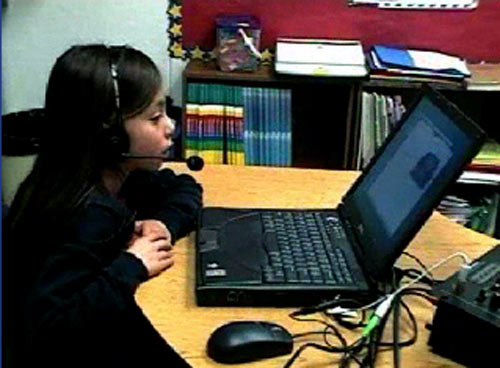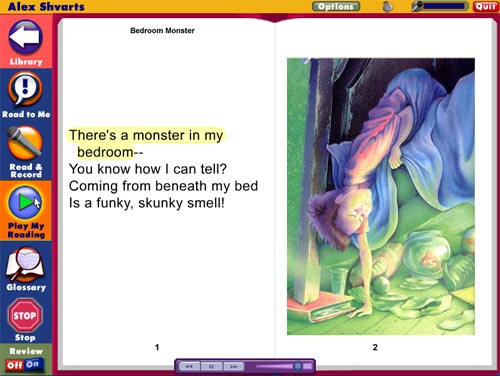« Leveling the Playing Field: SAT Math Pro | Main | MIT Open Courseware: Introduction To Biology »
November 4, 2005
Soliloquy Reading Assistant: Turning the Computer into A Personalized Tutor

Most of the projects on nexttext highlight ways in which electronic media is changing the format of the textbook--extending and enhancing content. But digital technology also presents an opportunity to change the format of the learning experience, extending and enhancing the teacher. Our most recent profile, SAT Math Pro, used animation and audio software to capture and present a real teacher explaining a math problem. Soliloquy Reading Assistant takes it a step further, using voice recognition software which "listens" as a student reads out loud, and responds with audio-visual commentary tailored to the individual needs of that reader.
This simulated tutor extends the reach of the teacher, providing the kind of individual attention that is (according the website) scientifically proven to improve fluency. To use Soliloquy Reading Assistant, the student puts on a headset (see above), logs in and selects a book from the "library." Content is provided by leading educational publishers including: Caras, Pearson, Scott Foresman, and Charlesbridge Publishing. Once a book is selected, the student can choose to hear it read via the "Read to me" feature or she/he can simply begin reading into the microphone. Voice recognition and analysis software "listens" and when the student mispronounces a word it responds by reading the word correctly. If the student hesitates over a word, but does not mispronounce it, the word is added to the "review" list. Upon completion of the story, students can play back their voice recording and hear how they did. The "Review" feature identifies words the student has mastered as well as words that need practice. To help build vocabulary, students can take advantage of a context sensitive glossary. Students are further engaged by a system of "Power Points" awarded each time a story is completed. The more students read, the more Power Points they will rack up. A "Progress Screen" shows the results of their current reading and a log of their past readings.

As you can see in the screen grab above, the electronic version looks very much like the print book, fully illustrated with large, easy-to-read type. Soliloquy also has additional accessibility settings to help users with low vision or motor skills.
Teachers using Soliloquy also have an array of tools at their disposal. They can quickly check on the progress of each student from their own computer, listen to the students' audio recordings and make automatic assignments.
Through two basic types of reports, they can see how much students read and at how many words per minute.
The Reading Assistant Manager's 'Usage Report' provides the following information for each student: reading time, listening time, quiz time, total usage, number of completed titles, last session date and total number of sessions - Reports and data can be exported to be included in grant proposals, larger reports, and student information systems.
The 'Fluency Report' provides teachers with: date of last session, number of completed titles, average text level, total number of readings, Words-Correct-Per-Minute for the first and last readings, as well as average Words-Correct-Per-Minute. Teachers can also create custom reports, choosing from a list of topics. Administrators only may also create reports based on student criteria such as ESL, free lunch, ethnicity, etc.
Breakthrough products like Soliloquy Reading Assistant are exciting because they allow us to start thinking about a future where simulated teachers are built into all electronic textbooks. The question to ponder is: what will the emergence of the robotic teacher mean for the future of education itself? There are some clear advantages. This technology greatly improves learning for students enrolled in large classes where they get little individual attention. I'm concerned, however, that as these technologies develop, they might be seen as acceptable replacements for real teachers.
Another drawback: a robotic tutor can't provide uniquely human forms of encouragement that are conveyed via gesture, expression and a whole array of non-verbal communications which give students positive messages about their abilities and their potential. On the flipside: a robotic tutor can't provide uniquely human forms of discouragement that are conveyed (intentionally or unintentionally) via gesture, expression and a whole array of non-verbal communications which give students negative messages about their abilities and their potential.
I'll just add one more subjective response I had to the Soliloquy demo. To make the point clear, I'll contrast it with the response I had to SAT Math Pro. Since I knew the "virtual teacher" was Colleen King, a real person and a teacher, I felt the voice was somehow embodied and the message was trustworthy. The Soliloquy tutor, by contrast, was an unknown entity, who sounded more like a voice actor than real teacher. It's a subtle thing and I don't know if it will register with kids, but the slickness of the vocal performance made it more difficult for me to engage.
But all criticism (and future speculation) aside. Soliloquy Reading Assistant is a superb example of "what happens when textbooks go digital."
Posted by kim white at November 4, 2005 7:41 AM
